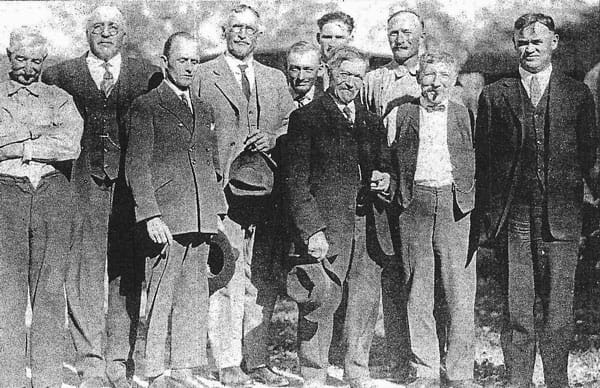Cheese Louise! The dairy industry in Douglas County

The Big Dry Creek Cheese Ranch was established by Johann Welte (center right with dark suit).
By Joe Gschwendtner; photo courtesy of Scott Terhark Collection, Douglas County History Research Center, Douglas County Libraries
Not long after the Homestead Act opened the West, some Douglas County settlers became farmers and ranchers. Rolling terrain of small valleys and gulches with low density population offered vast open areas rife with protein-rich grasses ideal for grazing.
Livestock thrived and distribution channels developed. Common to many county dairy farmers was a hardy breed of Milking Shorthorn cattle introduced to the U.S. in the late 1700s. They were ideal, as they could handle the occasional harsh winter and produce milk high in butterfat. By 1900, some 3,000 cows were being milked in the county.
At one time there were seven creameries here. Raw milk typically found its way to collection stations, separators, or the creameries themselves via horse-drawn wagons. In 1900, there were seven such facilities: Castle Rock, Hill Top, Sedalia, Parker, Larkspur, Spring Valley and Franktown. Four cheese factories were located in northern Douglas County, the most famous among them being the Welte Big Dry Creek Ranch within today’s Highlands Ranch boundaries.
One of the more interesting stories is that of the Welte Cheese Ranch, a separate operation within it. Austrian John Welte had immigrated directly here around 1870 with brother-in-law Plazeda Gasner. Neither spoke a word of English, not that it mattered. Such was the quality of their agricultural skills and cheese making methods they were regularly talked up in farm journals of the time.
The cheese ranch became famous for other reasons, as the scene of memorable social events. Some called it a beer garden as revelers came to consume Welte Cheese products with suds, using the ranch house as a dance hall and card-playing venue.
Another bovine success story was Carson Frink, who had four dairy stations in the county. Starting in Larkspur, he expanded to Sedalia, Castle Rock and Cherry Valley. In 1921, Frink purchased almost 10 million pounds of milk for processing, his most famous product being Black Canyon Cheese. Not satisfied with mere local success, Frink opened a plant in Manassas in the San Luis Valley. In 1925, that plant produced a cream cheese of such quality it won a silver medal at the 10th National Dairy Exposition in Indianapolis, Indiana.
Early cheese making followed similar procedures. Milk was first weighed, tested, recorded and added to massive vats. Since an occasional farmer would extend (add water) to his milk, a test was developed to catch the cheaters. The vats would be steam heated to 80 degrees.
Coloring and rennet were then added to the slurry yielding a custardy material. After cooking and settling, the mass was cut into chunks of curd. Remaining whey was sluiced off to an accumulator, which farmers could use as food for pigs and calves. To shape the curd, it was put into a press. After setting overnight, it was removed the next morning to be cured for a month.
Alas, the Douglas County dairy industry shrank inversely with population growth. In the 2017 census, fewer than 100 cows were reported; a clear sign the dairy industry had ‘moo’ved on.
Wildcat Lore
As it turns out, The Connection serves residents of the Wildcat Mountains, a name pioneers and historians gave to the high country paralleling I-25 from Highlands Ranch and Lone Tree south to Castle Rock. Since the first territorial road (Daniels Park Road) bisected our mountains, there was no shortage of colorful characters parading through what are now private properties on the ridges of Douglas County. We bring these grizzled and gutsy settlers alive again, vividly sharing their stories of grit and achievement in these Castle Pines.